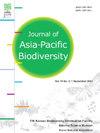印尼苏门答腊岛特有濒危兰花蕙兰(Cymbidium hartinahianum)叶绿体全基因组及系统发育定位
IF 0.7
Q4 BIODIVERSITY CONSERVATION
引用次数: 0
摘要
蕙兰(Cymbidium: Epidendroideae)包括具有重要园艺和生态意义的种,但对印度尼西亚北苏门答腊特有的蕙兰(Cymbidium hartinahianum)的分布和系统发育研究有限。本文报道了春兰(Cymbidium hartinahianum)的完整质体基因组。利用Illumina平台对整个质体基因组进行测序,随后进行质体组装、注释和可视化。全长150,370 bp的圆形基因组具有典型的四分体结构,由84,189 bp的大单拷贝区(LSC)、14,611 bp的小单拷贝区(SSC)和25,785 bp的一对倒置重复区(IRs)组成。质体基因组总GC含量为37.0%。注释共发现148个基因种,其中蛋白质编码基因96个,转移RNA 52个,核糖体RNA (rRNA)基因4个。基于52个质体的贝叶斯和最大似然系统发育分析证实,C. hartinahianum是C. floribundum的姐妹,属于蕙兰科floribundum。这一新测序的质体数据将为今后蕙兰的系统基因组学和生物地理学研究提供有价值的数据。它还为保护工作提供了新的分子数据,包括DNA条形码,以帮助防止这种濒危兰花的非法贸易。本文章由计算机程序翻译,如有差异,请以英文原文为准。
The complete chloroplast genome and phylogenetic position of Cymbidium hartinahianum, an endemic and endangered orchid of Sumatra, Indonesia
Cymbidium (Orchidaceae: Epidendroideae) includes species of significant horticultural and ecological importance, yet limited research exists on the distribution and phylogeny of Cymbidium hartinahianum, an orchid endemic to North Sumatra, Indonesia. Here, we present the complete plastid genome of Cymbidium hartinahianum. The whole plastid genome was sequenced using the Illumina platform, followed by a pipeline for plastome assembly, annotation, and visualization. The circular genome with a length of 150,370 bp possesses the typical quadripartite structure, consisting of a large single-copy (LSC) region of 84,189 bp, a small single-copy (SSC) region of 14,611 bp, and a pair of inverted repeats (IRs) regions of 25,785 bp. The plastid genome has a total GC content of 37.0%. Annotation revealed 148 gene species, including 96 protein-coding genes, 52 transfer RNA, and four ribosomal RNA (rRNA) genes. Bayesian and maximum likelihood phylogenetic analyses based on 52 plastomes confirmed that C. hartinahianum is sister to C. floribundum and belongs to the Cymbidium section Floribundum. This newly sequenced plastome data will be valuable for future Cymbidium phylogenomic and biogeographical studies. It also provides new molecular data for conservation efforts, including DNA barcoding to help prevent the illegal trade of this endangered orchid.
求助全文
通过发布文献求助,成功后即可免费获取论文全文。
去求助
来源期刊

Journal of Asia-Pacific Biodiversity
Agricultural and Biological Sciences-Insect Science
CiteScore
1.70
自引率
12.50%
发文量
94
审稿时长
27 days
期刊介绍:
The Journal of Asia-Pacific Biodiversity (previous title was Journal of Korean Nature) is an official journal of National Science Museum of Korea (NSMK) and Korea National Arboretum (KNA). The scope of journal is wide and multidisciplinary that publishes original research papers, review articles, as well as conceptual, technical and methodological papers on all aspects of biological diversity-its description, analysis and conservation, and its application by humankind. This wide and multidisciplinary journal aims to provide both scientists and practitioners in conservation theory, policy and management with comprehensive and applicable information. However, papers should not be submitted that deal with microorganisms, except in invited paper. Articles that are focused on the social and economical aspects of biodiversity will be normally not accepted.
 求助内容:
求助内容: 应助结果提醒方式:
应助结果提醒方式:


